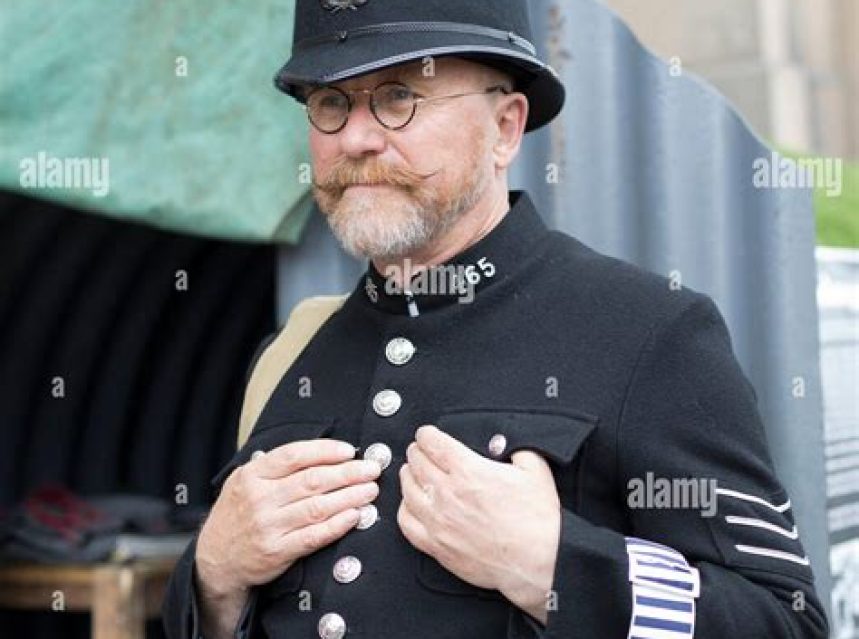Vintage Police Uniform

Vintage police uniforms have always captivated our collective imagination, conjuring images of sharp-dressed officers patrolling the streets with authority. In this blog post, we will delve into the historical evolution of these uniforms, tracing their origins back to the early days of law enforcement. We will explore the distinctive features that set them apart from contemporary uniforms, as well as their significance in representing authority and maintaining order. Additionally, we will examine the role vintage police uniforms have played in popular culture, from classic movies to iconic television characters. Lastly, for those interested in adding these pieces of history to their collection, we will provide helpful tips and recommendations for collecting vintage police uniforms. Join us as we embark on this fascinating journey through time and style.
Historical Evolution of Vintage Police Uniforms
Vintage police uniforms have a rich and fascinating history that spans back many decades. These uniforms not only served as a means for law enforcement officers to identify themselves, but they also served as a reflection of the changing times and societal norms. The historical evolution of vintage police uniforms showcases the development and transformation of law enforcement practices, as well as the influences of various factors such as fashion trends, technological advancements, and cultural shifts.
One of the earliest forms of vintage police uniforms can be traced back to the 19th century, where officers were often seen wearing traditional military-style garments. These uniforms typically featured high collars, brass buttons, and a tailored fit, resembling the attire of soldiers. This design choice was intentional, as it aimed to convey a sense of authority and discipline to the public.
During the early 20th century, there was a significant shift in the design of vintage police uniforms. With the rise of modern policing techniques and the need for increased visibility, law enforcement agencies began adopting more practical and functional uniforms. These uniforms often included features such as detachable badges, reinforced trousers, and a distinct color scheme to differentiate officers from the general public.
As time went on, vintage police uniforms started to incorporate more customized elements that reflected regional or departmental characteristics. For example, some uniforms featured unique patches or insignias that represented a specific city or state, while others introduced accessories such as hats or boots that were specific to a particular region. These variations added a touch of individuality and pride to the law enforcement officers who wore them.
Furthermore, the historical evolution of vintage police uniforms has also been influenced by cultural and societal changes. In the mid-20th century, for instance, the civil rights movement prompted many law enforcement agencies to reconsider their uniforms in order to foster a more approachable and community-oriented image. This led to the adoption of softer fabrics, lighter colors, and the inclusion of community outreach symbols on the uniforms.
| Decade | Advancements |
|---|---|
| 1920s | Inclusion of reinforced trousers for increased durability. |
| 1950s | Introduction of softer fabrics and lighter colors for improved comfort and community-oriented image. |
| 1970s | Incorporation of reflective materials for enhanced visibility and safety. |
The historical evolution of vintage police uniforms is a fascinating journey that reflects not only the changes in law enforcement practices but also the societal shifts and cultural influences of each era. From the traditional military-style uniforms of the 19th century to the more community-oriented and practical designs of the present day, these uniforms continue to hold a significant place in the history of law enforcement.
Distinctive Features of Vintage Police Uniforms
Distinctive Features of Vintage Police Uniforms
Distinctive Features of Vintage Police Uniforms
Police uniforms have undergone significant changes throughout history, reflecting the evolving role and requirements of law enforcement. Vintage police uniforms, in particular, have a charm and uniqueness that captivate enthusiasts and collectors. These uniforms are not only a visual representation of the past but also carry distinct features that set them apart from contemporary attire.
The following distinctive features can be found in vintage police uniforms:
1. Unique Color Schemes
One of the most striking aspects of vintage police uniforms is the distinct color schemes used. Unlike modern uniforms that predominantly feature darker shades, vintage uniforms often showcased vibrant hues. For example, some early 20th-century police forces opted for a dark navy blue combined with golden accents, while others embraced the classic black-and-white ensemble.
2. Ornate Badges and Insignias
Vintage police uniforms were adorned with ornate badges and insignias to denote rank, department, and other important distinctions. These emblems were often crafted with intricate details, such as specific patterns, symbols, or engravings, which added an air of prestige and authority to the uniform.
3. Tailored and Formal Designs
In the early years, vintage police uniforms were tailor-made to ensure a perfect fit for each officer. These uniforms had a formal and professional appearance, representing the authority and respect associated with the role of law enforcement. Features like brass buttons, high collars, and double-breasted jackets were commonly seen elements in vintage police attire.
4. Utilitarian Accessories
Vintage police uniforms were equipped with utilitarian accessories suitable for the specific needs of an officer on duty. Accessories such as utility belts, holsters, nightsticks, and wide-brimmed hats were common additions to enhance functionality and overall efficiency.
5. Symbolic Headgear
Headgear played an essential role in vintage police uniforms, with different styles representing specific departments or regions. For instance, the iconic custodian helmet, also known as the “bobby helmet,” was prominently worn by British police officers.
In conclusion, vintage police uniforms possess distinctive features that set them apart from their modern counterparts. The unique color schemes, ornate badges and insignias, tailored and formal designs, utilitarian accessories, and symbolic headgear all contribute to their appeal and historical significance. Collectors and enthusiasts are drawn to these uniforms as they represent not only a piece of the past but also the honor and dedication of law enforcement throughout history.
The Role of Vintage Police Uniforms in Law Enforcement
Vintage police uniforms have played a crucial role in law enforcement throughout history. These uniforms not only identify officers, but also serve as symbols of authority, professionalism, and community protection. They have evolved over time to meet the changing needs of law enforcement agencies and reflect the societal attitudes towards policing. Vintage police uniforms are not just fashion statements, they carry significant meaning and importance in the world of law enforcement.
One of the primary roles of vintage police uniforms is to establish a visual presence of authority. When members of the public see a police officer in uniform, they immediately recognize that help is at hand and that they can rely on the officer to maintain order and uphold the law. The uniform acts as a psychological deterrent to potential criminals, as it represents an organized and disciplined force prepared to take action when necessary.
Moreover, vintage police uniforms contribute to creating a sense of trust and accountability within the community. The uniform is a symbol of the officer’s dedication to public service and their commitment to protecting and serving the community. By wearing these distinctive uniforms, officers demonstrate their affiliation to a higher cause and their willingness to put themselves in harm’s way for the greater good.
Additionally, vintage police uniforms have adapted to the specific needs of different law enforcement units and eras. For example, in the early years of modern policing, officers wore uniforms that resembled military attire to maintain a sense of authority and discipline. As law enforcement evolved and community policing became a prominent approach, uniforms also underwent changes to reflect a more approachable and community-friendly image.
Vintage police uniforms have also played a significant role in establishing a sense of tradition and history within law enforcement agencies. These uniforms encapsulate the legacy of policing and connect modern officers with the long-standing traditions and values of their organizations. Law enforcement agencies often preserve and display vintage uniforms as a way to honor the past and acknowledge the sacrifices made by previous generations of officers.
- Visual presence of authority
- Establishing trust and accountability
- Adapting to the needs of different units and eras
- Preserving tradition and history
| Vintage Police Uniforms | Role in Law Enforcement |
|---|---|
| Create a visual presence of authority | The uniform acts as a psychological deterrent to potential criminals, as it represents an organized and disciplined force prepared to take action when necessary. |
| Establish trust and accountability | The uniform is a symbol of the officer’s dedication to public service and their commitment to protecting and serving the community. |
| Adapt to the needs of different units and eras | Vintage police uniforms have evolved over time to meet the changing needs of law enforcement agencies and reflect societal attitudes towards policing. |
| Preserve tradition and history | Vintage police uniforms connect modern officers with the long-standing traditions and values of their organizations, honoring the sacrifices made by previous generations of officers. |
Iconic Vintage Police Uniforms in Pop Culture
When it comes to making a lasting impact in the world of fashion, vintage police uniforms have played a significant role. These uniforms have not only served as symbols of authority and law enforcement but have also become iconic representations of power and style. Throughout history, numerous television shows, movies, and music videos have showcased vintage police uniforms, giving them a prominent place in pop culture. Let’s take a closer look at some of the most memorable vintage police uniforms that have left an indelible mark on our collective imagination.
Firstly, one cannot discuss iconic vintage police uniforms without mentioning the classic detective trench coat. This long, tailored coat has become a signature in pop culture, representing the detective archetype. With its deep pockets and sleek design, the trench coat exudes an air of mystery and sophistication. Films like “Casablanca” and television series like “Sherlock Holmes” have immortalized this piece of clothing, elevating it to an iconic status.
In addition to the detective trench coat, the stylish fedora hat has also become synonymous with vintage police uniforms in popular culture. This hat, often worn tilted at a rakish angle, instantly conveys an aura of authority and intrigue. From old Hollywood films like “The Maltese Falcon” to contemporary crime dramas like “The Untouchables,” the fedora hat has been a staple accessory, adding an extra layer of charm and sophistication to the uniform.
- The trench coat
- The fedora hat
- Classic leather jackets
| Iconic Vintage Police Uniforms | In Pop Culture |
|---|---|
| The detective trench coat | Featured in films like “Casablanca” and TV series like “Sherlock Holmes” |
| The stylish fedora hat | Seen in old Hollywood films like “The Maltese Falcon” and contemporary crime dramas like “The Untouchables” |
| Classic leather jackets | Popularized by shows like “Starsky and Hutch” and movie franchises like “Dirty Harry” |
Moreover, classic leather jackets have also made a significant impact on the portrayal of vintage police uniforms in pop culture. These jackets, often adorned with badges and insignias, exude a sense of ruggedness and rebellion. Shows like “Starsky and Hutch” and movie franchises like “Dirty Harry” have popularized the image of police officers donning these iconic leather jackets, giving them an edgy and cool persona.
In conclusion, vintage police uniforms have become iconic in pop culture, thanks to their portrayal in various forms of media. The detective trench coat, stylish fedora hat, and classic leather jackets have all contributed to the enduring allure of these uniforms. Whether it be on the big screen or the small screen, these iconic uniforms continue to capture our imagination and shape our perception of law enforcement in a stylish and captivating way.
Collecting Vintage Police Uniforms: Tips and Recommendations
Are you a fan of vintage police uniforms? Do you appreciate the historical significance and unique style of these uniforms? If so, you might be interested in starting your own collection. Collecting vintage police uniforms can be a fascinating and rewarding hobby, allowing you to delve deep into the history of law enforcement and showcase these iconic pieces of clothing. However, it’s important to approach your collection with knowledge and care. In this blog post, we will provide you with some valuable tips and recommendations to help you get started on your journey as a collector of vintage police uniforms.
1. Do Your Research:
Before diving into the world of collecting vintage police uniforms, it’s crucial to do thorough research. Familiarize yourself with the different eras and styles of uniforms worn by law enforcement officers throughout history. Gain knowledge about the insignia, buttons, and accessories that define each uniform. This background information will not only help you identify authentic pieces but also give you a deeper appreciation for the significance of each item in your collection.
2. Network and Connect:
Building connections with fellow collectors, enthusiasts, and experts in the field is invaluable when it comes to collecting vintage police uniforms. Attend relevant conferences, seminars, and collector’s fairs where you can meet like-minded individuals who share your passion. Engaging in discussions, sharing your knowledge, and seeking advice from experienced collectors will help you learn more about the authenticity, rarity, and value of different uniforms, allowing you to make informed decisions when adding to your collection.
3. Preserve and Protect:
Preservation is a crucial aspect of collecting vintage uniforms. Ensure that you handle the uniforms with care, using acid-free tissue paper and archival-grade garment bags to store and protect the fabric. Additionally, avoid exposing the uniforms to direct sunlight, extreme temperature fluctuations, or high levels of humidity, as these can cause irreversible damage. Regularly inspect your collection for signs of wear or deterioration and take necessary measures to mitigate any potential damage.
| Tips | Recommendations |
|---|---|
| Do research on each uniform’s historical context | Connect with experts and fellow collectors |
| Handle uniforms with care using archival-grade storage | Mitigate damage caused by sunlight, temperature, and humidity |
Frequently Asked Questions
Question 1: How have vintage police uniforms evolved over time?
Vintage police uniforms have undergone significant changes throughout history, adapting to the evolving needs and styles of law enforcement. Initially, uniforms were simple and resembled civilian clothing, but as law enforcement became more organized, uniforms started to incorporate distinctive features and symbols of authority.
Question 2: What are some distinctive features of vintage police uniforms?
Vintage police uniforms often featured unique elements that set them apart. These included specific color schemes for different ranks or departments, brass buttons and badges, insignias representing the agency or city, and accessories such as hats or caps.
Question 3: What role did vintage police uniforms play in law enforcement?
Vintage police uniforms served multiple purposes in law enforcement. Firstly, they provided officers with a recognizable and authoritative appearance, instilling confidence and respect in the community. Secondly, they helped establish a sense of discipline, professionalism, and unity among officers. Lastly, the uniform acted as a symbol of law and order, reinforcing the presence and authority of the police.
Question 4: Which iconic vintage police uniforms have left a mark in pop culture?
Several iconic vintage police uniforms have become synonymous with specific characters or TV series, leaving a lasting impact in pop culture. Examples include the classic tan uniforms of the California Highway Patrol depicted in the TV show “CHiPs,” the blue NYPD uniforms showcased in countless police dramas, and the iconic trench coats worn by detectives in film noir classics.
Question 5: What should one consider when collecting vintage police uniforms?
When collecting vintage police uniforms, it is crucial to prioritize authenticity, condition, and historical significance. Seek out uniforms from reputable sources or authenticated sellers, examine for any damage or alterations, and research the specific era or department the uniform represents to understand its historical value.
Question 6: How can one preserve and display vintage police uniforms?
To preserve and display vintage police uniforms, it is essential to store them in a cool, dry, and dark environment to prevent fading, discoloration, and damage from humidity or sunlight. Utilize acid-free archival materials, such as garment bags or acid-free boxes, to protect the fabric. When displaying the uniform, consider using conservation-friendly mannequins or frames designed specifically for textile preservation.
Question 7: Are vintage police uniforms sought-after collectibles?
Yes, vintage police uniforms are highly sought-after collectibles among enthusiasts, historians, and memorabilia collectors. The historical significance, unique design elements, and association with law enforcement make them desirable items for those interested in preserving and celebrating the history of police uniforms and the role they played in society.



